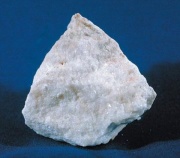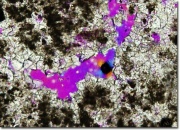Difference between revisions of "Travertine"
m (Text replace - "== Authority ==" to "== Sources Checked for Data in Record ==") |
|||
| (2 intermediate revisions by 2 users not shown) | |||
| Line 1: | Line 1: | ||
| − | [[File:06.1883a-b-E1925CR-d1.jpg|thumb|]] | + | [[File:06.1883a-b-E1925CR-d1.jpg|thumb|Offering table<br>MFA # 06.1883a-b]] |
== Description == | == Description == | ||
| − | A light-colored, porous rock composed primarily of [ | + | A light-colored, porous rock composed primarily of [[calcite|calcite]]. Travertine is a variety of [[limestone|limestone]] formed from multilayered [[calcium%20carbonate|calcium carbonate]] deposits in pools by the slow precipitation of mineral-rich spring water. The "holes" characteristic of travertine were produced by trapped [[carbon%20dioxide|carbon dioxide]] bubbles during its formation. Plant residues are often layered with the calcite deposits resulting in large elongated, often interconnected rings in the stone. Very porous, spongy travertine is called [[tufa|tufa]]. Travertine polishes to a matte finish. It is used as an interior and exterior building material. Thick deposit of travertine occur near Tivoli, Italy, and Mammoth Hot Springs in Yellowstone National Park. Banded travertine from Mexico is called [[Mexican%20onyx|Mexican onyx]] marble. |
[[File:Travertineemr1.jpg|thumb|Travertine]] | [[File:Travertineemr1.jpg|thumb|Travertine]] | ||
| Line 9: | Line 9: | ||
tufa limestone; false marble; Mexican onyx; Egyptian alabaster; frådsten (Dan.); kildekalk (Dan.); Travertin (Deut, Fr.); travertino (Esp., It.); (Ned.); (Pol.); (Port.); (Sven.); travertijn (Ned.) | tufa limestone; false marble; Mexican onyx; Egyptian alabaster; frådsten (Dan.); kildekalk (Dan.); Travertin (Deut, Fr.); travertino (Esp., It.); (Ned.); (Pol.); (Port.); (Sven.); travertijn (Ned.) | ||
| − | == | + | == Risks == |
No significant hazards. Noncombustible. | No significant hazards. Noncombustible. | ||
| + | [[File:travertinelarge.jpg|thumb|Travertine]] | ||
| − | == | + | == Resources and Citations == |
| − | |||
| − | |||
| − | |||
| − | |||
| − | |||
| − | |||
| − | |||
* Luciana and Tiziano Mannoni, ''Marble: the history of a culture'', Facts on File Publications | * Luciana and Tiziano Mannoni, ''Marble: the history of a culture'', Facts on File Publications | ||
| Line 30: | Line 24: | ||
* G.S.Brady, ''Materials Handbook'', McGraw-Hill Book Co., New York, 1971 Comment: p. 386 | * G.S.Brady, ''Materials Handbook'', McGraw-Hill Book Co., New York, 1971 Comment: p. 386 | ||
| − | * Website | + | * Website: http://www.marble-institute.com |
| − | * Wikipedia | + | * Wikipedia: http://en.wikipedia.org/wiki/Travertine (Accessed Nov. 9, 2005) |
* Michael McCann, ''Artist Beware'', Watson-Guptill Publications, New York City, 1979 | * Michael McCann, ''Artist Beware'', Watson-Guptill Publications, New York City, 1979 | ||
Latest revision as of 11:54, 22 August 2020
Description
A light-colored, porous rock composed primarily of Calcite. Travertine is a variety of Limestone formed from multilayered Calcium carbonate deposits in pools by the slow precipitation of mineral-rich spring water. The "holes" characteristic of travertine were produced by trapped Carbon dioxide bubbles during its formation. Plant residues are often layered with the calcite deposits resulting in large elongated, often interconnected rings in the stone. Very porous, spongy travertine is called Tufa. Travertine polishes to a matte finish. It is used as an interior and exterior building material. Thick deposit of travertine occur near Tivoli, Italy, and Mammoth Hot Springs in Yellowstone National Park. Banded travertine from Mexico is called Mexican onyx marble.
Synonyms and Related Terms
tufa limestone; false marble; Mexican onyx; Egyptian alabaster; frådsten (Dan.); kildekalk (Dan.); Travertin (Deut, Fr.); travertino (Esp., It.); (Ned.); (Pol.); (Port.); (Sven.); travertijn (Ned.)
Risks
No significant hazards. Noncombustible.
Resources and Citations
- Luciana and Tiziano Mannoni, Marble: the history of a culture, Facts on File Publications
- Anne Grimmer, Glossary of Building Stone Terms, A Glossary of Historic Masonry Deterioration Problems and Preservation Treatments, National Park Service, Washington DC, 1984
- C.W.Chesterman, K.E.Lowe, Audubon Society Field Guide to North American Rocks and Minerals, Alfred A. Knopf, New York, 1979
- G.S.Brady, Materials Handbook, McGraw-Hill Book Co., New York, 1971 Comment: p. 386
- Website: http://www.marble-institute.com
- Wikipedia: http://en.wikipedia.org/wiki/Travertine (Accessed Nov. 9, 2005)
- Michael McCann, Artist Beware, Watson-Guptill Publications, New York City, 1979
- Dictionary of Building Preservation, Ward Bucher, ed., John Wiley & Sons, Inc., New York City, 1996
- Van Nostrand's Scientific Encyclopedia, Douglas M. Considine (ed.), Van Nostrand Reinhold, New York, 1976
- Random House, Webster's Encyclopedic Unabridged Dictionary of the English Language, Grammercy Book, New York, 1997
- The American Heritage Dictionary or Encarta, via Microsoft Bookshelf 98, Microsoft Corp., 1998


